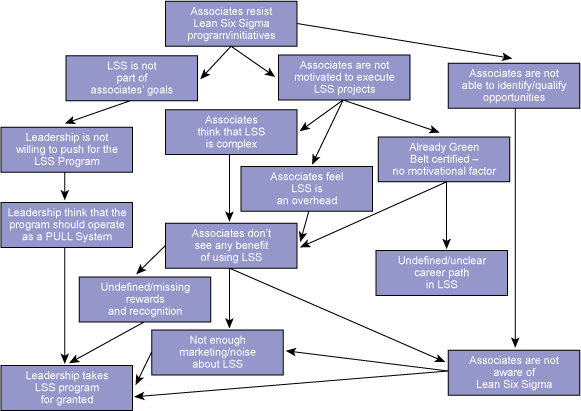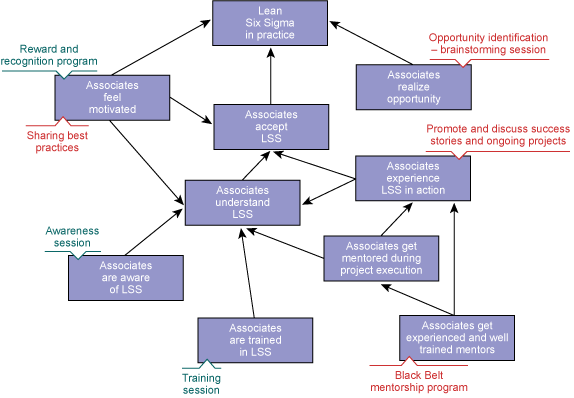
The Six Sigma world is filled with stories reiterating the importance of leadership focus when implementing Lean Six Sigma. However, the continuous improvement landscape is also littered with examples of Lean Six Sigma programs that were implemented in full force to start with and then were slowly abandoned after they had spread to other departments within the organization.
I have experienced this phenomenon first-hand. In this article, I want to share with you the path that one organization traversed and point out some of the interesting learning experiences. The causes of the organization’s problems with implementation momentum, and the possible solutions discussed here, may prove themselves to be vital reviving factors for other practitioners as well.
Situational Analysis
This organization was into the fifth year of its Lean Six Sigma implementation and had achieved all of its basic goals: 80 percent of the workforce was Green Belt-certified, 5 percent of the workforce was Black Belt-certified and current process metrics were in control.
At this stage, the program had reached a plateau: Employees were not interested in executing more projects. Employees didn’t see any personal or professional benefits, so it was hard to motivate them. The process metrics were not triggering any new thoughts. Corporate leadership were still nominally supportive of the program, but even with all of their collective knowledge of Six Sigma, they were numb about the program and didn’t want to pull any levers. The program required some innovation, but members of the leadership team were not willing to rely on their own intuition.
Rather than allowing the program to continue sinking, the leadership decided to seek help to save the ship. I began working with the company to address these issues. The first step was to conduct a root-cause analysis. The brainstorming session from this effort brought up the following significant causes for the decline of the program from two differing perspectives:
From a leadership perspective:
- Associates are not motivated to execute Lean Six Sigma projects
- Associates resist the program and its initiatives
- Associates didn’t see any benefits of using Lean Six Sigma
From the associates’ perspective:
- What is the benefit of executing a Lean Six Sigma project?
- What is the career path for me under this deployment?
- There are not enough opportunities
- Lean Six Sigma is too complex
All of these causes initially seemed to point toward the associates and their related motivational factors. We followed up this effort with an undesirable effect diagram (UDE), as seen in Figure 1. The diagram, when completed in conjunction with leadership, provided an altogether different picture.

After analyzing the flow of undesirable effects in the UDE diagram, leadership learned the following lessons about how its own attitude about Lean Six Sigma affected the program in a negative manner:
- Even though most of the causes for the decline seemed to be lack of enthusiasm from associates (and thus out of the immediate control area), the root cause generally lay with leadership (and is controllable).
- A Lean Six Sigma program, once implemented, cannot be left to itself. We continuously need to feed the plant, and associates also need continuous motivation.
Action Plan
The next step was to develop an action plan, listing critical tasks and realistic timelines that were required to address this situation. The first of the critical tasks were:
- Agreement that action must be taken by leadership
- Make sure that associates are aware about the importance of the Lean Six Sigma program
- Establishment of a rewards and recognition program for associates
- A marketing plan for the Lean Six Sigma program and its initiatives
With agreement from leadership, we established that the real benefits of Lean Six Sigma come from:
- The implementation of tools and framework on strategic, business oriented projects. In this case, implementation justifies itself and results in quantifiable critical business benefits.
- The implementation of Lean Six Sigma concepts into daily work life. In this case, the results are small, and a lot of small changes accumulate into huge benefit.
Thus, the critical success factor of any Lean Six Sigma program is not only the execution of large, business-oriented projects, but also is the execution of hundreds, or thousands, of smaller improvements. Even though the change enabler always must come from top leadership, the motivation for the changes can sometimes come from elsewhere in the organization. For large projects, the top leadership must ensure that projects meet strategic planning and policy goals. For the incremental changes, the associates – the bottom part of the organizational pyramid – can be the driving force.
As the UDE was being created, it was not difficult to get leadership involved actively. In fact, the leadership team took it upon themselves to revitalize the Lean Six Sigma program at the top level. A task force – a change execution team, with part-time team members – also was established to revitalize the program at the grassroots level. (The vision of this task force was “Lean Six Sigma in Daily Life,” [i.e., everyone should be able to implement a Lean Six Sigma tool/concept during daily life, at any appropriate point].)
Timeline for Action
At this point, a GRPI model (goals, roles, process(es), interpersonal) was performed to develop the change execution team. The task force was divided into sub-teams to attack individual areas. The team members were trained on Six Sigma, statistics and communication. These members were going to be the critical mass to initiate a chain-reaction, which would ultimately result in achievement of the mission.
From the GRPI, the team created a timeline for the action items. The following immediate, short-term goals were established.
In 0 to 4 Months:
- Make all new associates aware of Lean Six Sigma program within one month.
- Conceptualize and establish rewards and recognition within one month.
- Train 20 percent (non-certified) of the associates on Lean Six Sigma concepts (a rigorous two to three days of training) within three months.
- Establish regular awareness and training sessions by the end of four months.
- Recruit more members to the task force so that its size doubles by the end of four months.
In 4 to 8 Months:
After the four-month point, the organization had started seeing improvements. Associates were more aware about Lean Six Sigma. The queries about the program were more numerous and higher in quality. The situation was just right for the next set of improvements.
As the taskforce had, indeed, doubled as planned, it was also time to listen again for input from all the new members and to look for fresh and innovative ideas. A “7-How” brainstorming session was conducted with entire task force, the results of which can be seen in Figure 2.

The 7-How session helped the team identify some critical knowledge gaps. For instance, leadership realized that for each associate to fully embrace Lean Six Sigma, the associates need to 1) feel motivated to use the methodology, 2) accept the methodology as a way of improving the business and 3) realize the opportunities for improvement projects in their organization. . We identified the improvements required for our program and set up the following goals for the four- to eight-month period.
- Conceptualize and establish a program to build a Green Belt mentorship pool (at least 5 percent of our strength) by the seventh month. (Only certified Green Belt mentors would be allowed to mentor upcoming projects.)
- Conduct opportunity identification and brainstorming sessions for all the project teams by the seventh month.
- Conduct monthly on-the-floor promotional events to share best practices, discuss success stories and motivate associates.
One of the lessons we learned after implementing the mentoring program was that executing a Black Belt project is quite different than mentoring an associate. Mentorship is a skill, which needs to be developed explicitly. The Green Belt mentorship training was more focused on developing the mentorship skills than developing Six Sigma skills.
In 8 to 12 Months:
In keeping with the goal of never leaving a Lean Six Sigma program to fend for itself, the leadership team started its efforts to establish a regular schedule of activities and initiatives. At the same time, the team started tying the Lean Six Sigma program to the career paths of the associates. The leadership identified ways to add value to every associate’s career path. This ensured that they would not lose track; today, they continue to excel in this endeavor. The team also realized the importance of continuous communication with every associate via a series of established programs and channels.
Two Years Down the Line
Two years later, the taskforce was adding innovations to the Lean Six Sigma program and complementing the leadership team with their efforts. The organization continued to enjoy the fruits of the mammoth efforts. The top leadership also took pride in their decision to revitalize the program and understood the fact that they need to play an active, continuous role to ensure the success of their Lean Six Sigma program.